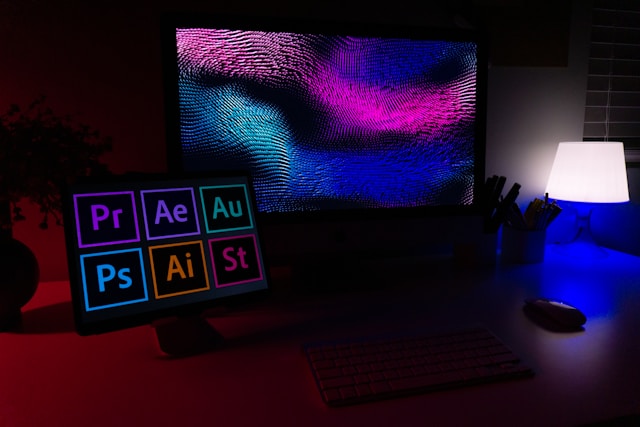
Key Takeaways
- The transformative role of graphic design infuses strategic business communication with aesthetic power.
- Empirical, psychological approaches to graphic design in marketing are essential to captivate and convert audiences.
- Emergent design trends influenced by technology are revolutionizing graphic design’s impact on business.
Table of Contents
- Introduction to Graphic Design as a Business Tool
- Historical Perspectives on Graphic Design
- The Psychological Impact of Graphic Design in Marketing
- Graphic Design and Website Effectiveness
- The Interaction Between Graphic Design and User Engagement
- The Future and Trends of Graphic Design in Business
- Integrating Graphic Design in Social Media Marketing
- Ethical Considerations in Commercial Design
- Case Study: Impactful Graphic Design Campaigns
- Crafting Your Visual Identity: Tips and Best Practices
Graphic design, a term often synonymous with a brand’s visual storytelling, has shown immense worth in the business communications stratosphere. It’s a kind of art in which ideas, words, and images are combined to communicate with an audience and typically have a predetermined outcome. In business, this effect captures attention, influences decision-making, and ultimately drives consumer behavior. Whether assessing the eye-catching attributes of exterior signage in Glen Burnie, MD, or the subtle nuances of a website’s user interface, the undeniable impact of graphic design is observed everywhere.
The role of graphic design stretches far beyond creating pretty pictures; it plays a crucial part in a brand’s strategic positioning and differentiation within a crowded market. Modern businesses leverage design to build identity, establish credibility, and foster an emotional connection with customers. The power to create visual coherence across various media platforms characterizes graphic design’s indispensable nature in achieving successful business communications.
Introduction to Graphic Design as a Business Tool
Graphic design services serve as a sophisticated means for businesses to engage with their stakeholders effectively. Beyond mere business tools, they evolve into a distinct language of color, form, and composition. This language communicates messages that transcend traditional boundaries, fostering meaningful connections. Similarly, exterior signage Glen Burnie MD, reflects this notion, where the artistry of graphic design converges with practicality to convey messages that resonate with viewers. The purpose of graphic design in a business is to beautify and functionally contribute to a company’s communication objectives. It serves as a bridge between the business and its audience, facilitating a better understanding of the services or products offered and distinguishing the brand in the minds of consumers.
Historical Perspectives on Graphic Design
The history of graphic design is rich and varied, moving from the handcrafted typography and imagery of the pre-digital ages to the sophisticated digital graphics of today. Gutenberg’s printing press set the stage for the democratization of information, a concept central to modern design. Since then, each design era has brought its own aesthetic and functional innovations, from the Bauhaus movement’s form-and-function ethos to the advent of the personal computer that brought graphic design to the masses. Understanding the trajectory of graphic design history helps us appreciate the current confluence of technology and art in crafting powerful business messages.
The Psychological Impact of Graphic Design in Marketing
The intersection of psychology and graphic design is a fascinating aspect that shapes marketing strategies. For instance, the right combination of colors can elicit specific emotions and associations that are universally or culturally ingrained, affecting the consumer’s perception of a brand. Typography, too, carries with it the weight of readability and emotion, crucial for effective communication. Using these psychological principles, graphic designers create sophisticated marketing materials that attract and retain the target audience’s attention, transforming passive viewers into active participants in the brand narrative.
Graphic Design and Website Effectiveness
A website is often the first point of contact between a business and potential customers. The quality of its design can significantly influence a user’s decision to stay or leave. As digital interfaces become the storefronts of today, graphic design is essential in ensuring that websites are aesthetically pleasing and functionally intuitive. From navigation to branding elements, each aspect of a site’s design provides a seamless, engaging user experience, thus promoting better interaction and retention rates.
The Interaction Between Graphic Design and User Engagement
The dynamism of graphic design is demonstrated through its ability to facilitate user interaction and engagement. A well-designed piece of content utilizes visual cues to guide the user on a journey through the information, establishing an efficient flow of communication. Every button’s placement, every color choice, and every image used is deliberate, aiming to foster a connection with the user and make the overall interaction as intuitive and enjoyable as possible. These subtleties define the user’s experience, impacting not only individual engagement but the overall success of a given platform or campaign.
The Future and Trends of Graphic Design in Business
Design is an ever-evolving field; it mirrors technological changes, societal demands, and consumer behavior. With the digital world making giant leaps, graphic design is poised for significant transformations. New paradigms are being created by the emergence of augmented and virtual reality and the use of AI in design processes. Trends such as these forecast an exciting era for graphic design, where the boundaries between user and content are blurred, and personalized experiences become the norm. Innovation drives design thinking away from static visuals toward interactive, immersive experiences that captivate users.
Integrating Graphic Design in Social Media Marketing
The explosion of social media platforms has seen graphic design adapt to a whole new ecosystem of content creation and distribution. Social media is predicated on visuals—images, videos, GIFs—and the power of a well-crafted design to cut through the noise is unparalleled. From profile imagery to infographics, every design element in social media marketing is a potential touchpoint that can foster a lasting impression. Therefore, a strategic approach to visual content on these platforms can significantly enhance engagement and drive authentic and memorable brand awareness.
Ethical Considerations in Commercial Design
Businesses and designers must be mindful of the ethical implications of wielding the power of visual persuasion. Graphic design should be practical and responsible, fostering transparency and truthfulness. Ethical design practices consider the broader societal impact, ensuring that messaging is inclusive and non-exploitative. Navigating these ethical waters is crucial for maintaining trust and credibility with the audience and upholding the design profession’s integrity.
Case Study: Impactful Graphic Design Campaigns
Studying successful design campaigns reveals the myriad ways in which robust graphic design can propel a business forward. For example, a well-executed branding exercise that resonates with an audience can substantially increase brand recognition and loyalty. These campaigns often serve as benchmarks for the industry, offering valuable insights into the strategies and execution that drive meaningful results. Observing these success stories illuminates the role of design in achieving communication objectives and business outcomes.
The strategic deployment of graphic design in business communications has never been more critical. From establishing brand identity to driving user interaction, its influence permeates every touchpoint. As we move forward into a technologically advanced future, the interplay between design and business will undoubtedly grow more intimate, harnessing new tools and platforms to create something truly remarkable—a future where design is not just seen but felt and where brands do not just speak, but listen and adapt.




More Stories
Understanding the Importance of Regular Electrical Maintenance in Homes
Ways Machine Vision Integration Can Revolutionize Manufacturing
Understanding Personal Injury Law: A Comprehensive Guide to Your Legal Rights and Obligations